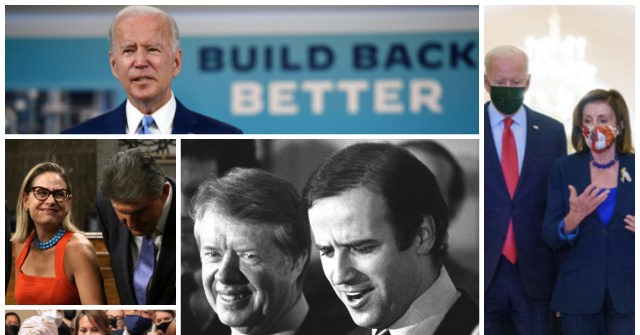Here’s a headline to ponder, courtesy of our friends at the New York Times: “Biden Throws In With Left, Leaving His Agenda in Doubt.”
The subhead atop that October 2 article, concerning President Joe Biden’s domestic agenda, added more juice: “Progressives flexed, but remain empty-handed. Moderates feel betrayed. The outcome of their battle could determine Democrats’ fate in the midterms and the success of the Biden presidency.”
So there we have it: Joe Biden has moved to the left, which pleases the left, and yet the left hasn’t yet won its big policy fight on new spending. In the meantime, moderate (relative term) Democrats feel “betrayed.” In the view of these moderates, the man who once touted himself as “Middle Class Joe” is more like “Progressive Joe.” And such lefty-ness is political poison in swing districts. And so, the Times adds that this intra-party spat could cause the Democratic Party to do poorly in the 2022 midterm elections.
So yes, the stakes are high for Biden and for the nation. The specific matters at hand are the $1.2 trillion infrastructure bill (formally known as the Bipartisan Infrastructure Framework, or BIF) and the $3.5 trillion “human infrastructure” bill (Building Back Better, or BBB). Another name for BBB, of course, is “giant social-welfare spending spree.”
These past few months, the two bills (BIF and BBB) have been fused together, such that Biden and the Democrats seem to have put themselves in all-or-nothing position. That is, to get one, they must get both—unless, of course, they get neither. (It’s also possible that they could secure passage of the $1.2 trillion BIF and a shrunken version of the $3.5 trillion BBB—which, even if shrunk, would still be denominated in trillions, although spin-happy Democrats have sometimes tried to pretend that the cost will actually be zero.)
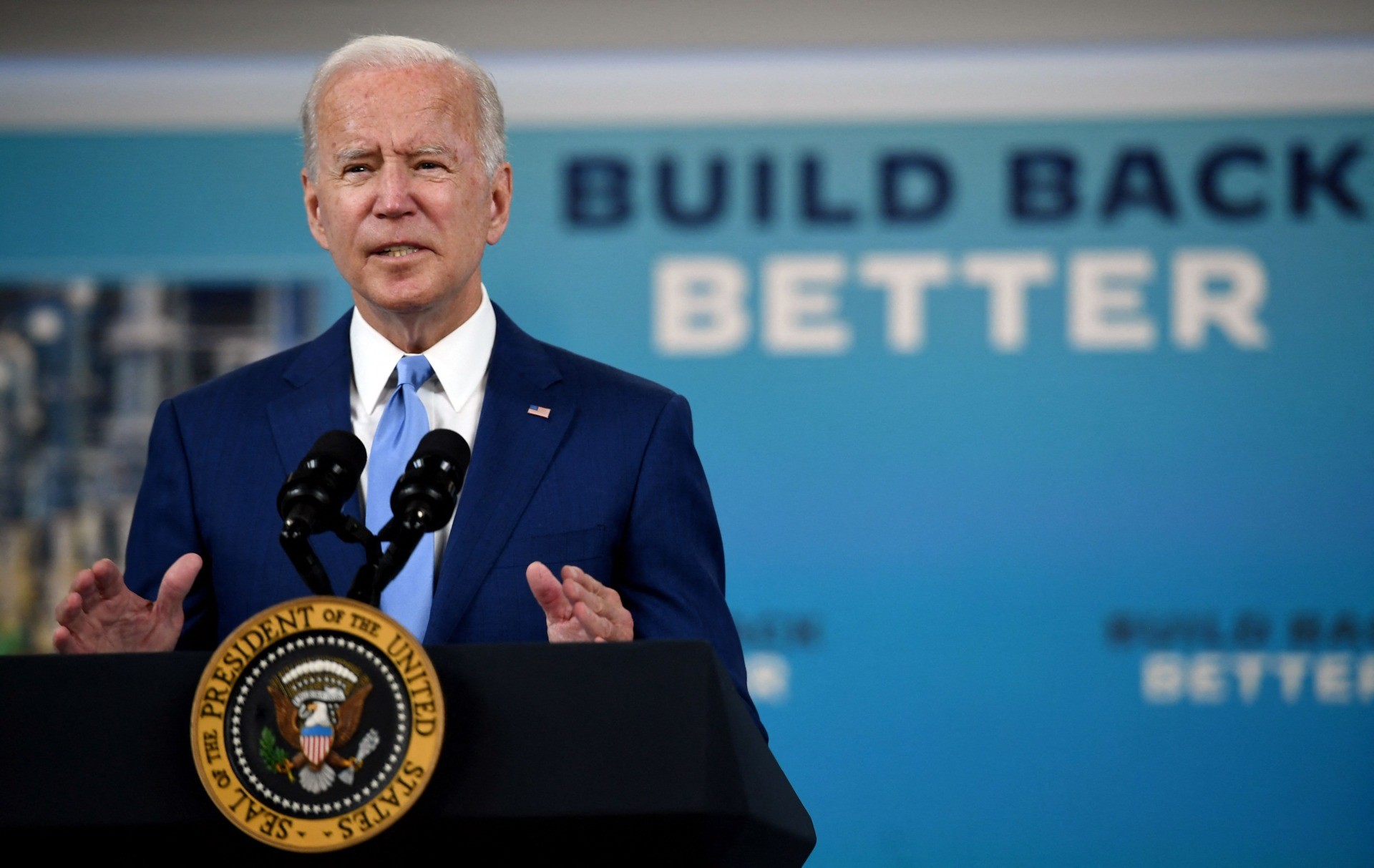
President Joe Biden speaks at the White House on October 8, 2021. (OLIVIER DOULIERY/AFP via Getty Images)
All this drama is playing out before our eyes on Capitol Hill, as the hard left, led by Rep. Pramila Jayapal (D-WA), the chair of the 96-member Congressional Progressive Caucus, finds herself ranged against a dwindling number of moderate Democrats, such as Rep. Josh Gottheimer of New Jersey, as well as, of course, Sens. Joe Manchin and Kyrsten Sinema.
It’s possible that some creative compromise will emerge from this mix, and yet every day that goes by—with each side issuing public insults and ultimatums to the other—makes it all the harder to see these feuding factions finding common ground. For instance, Biden has reportedly joked that a sit-down meeting between Sanders and Manchin would result in “homicide.”
In such a situation, a strong president might be able to disarm the two sides and achieve a deal. And yet this president is proving to be more of a bystander than a player. On October 1, he traveled to the Capitol to try and make peace; the trip did not succeed. Rep. Dean Phillips (D-MN, a moderate who won a Republican seat in 2018, said afterward that Biden’s visit was a “nothing burger,” adding that the president’s effectiveness as a mediator between the factions had “been sadly diminished.”
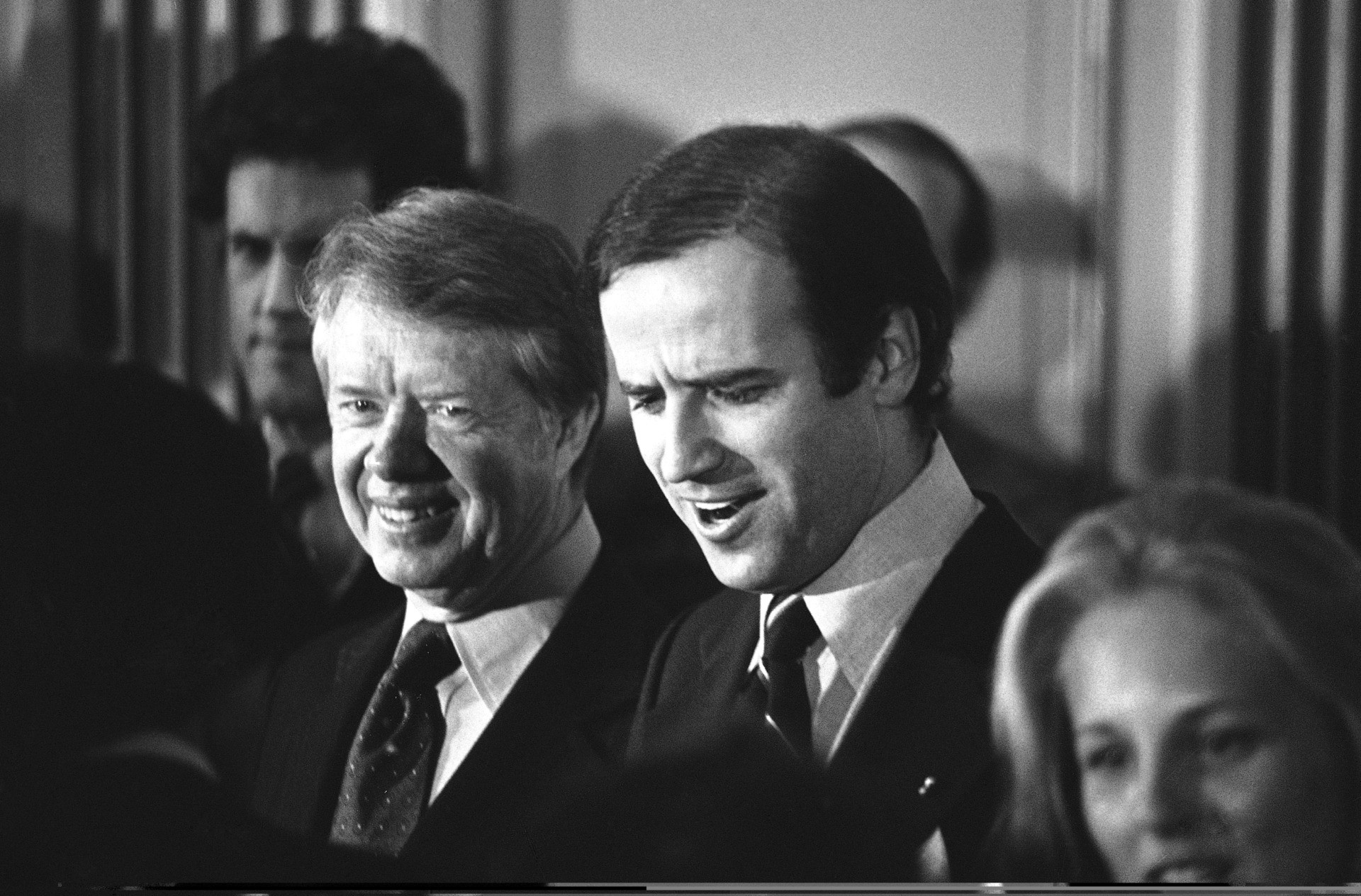
President Jimmy Carter and Sen. Joe Biden greet Biden supporters at a $1,000-a-couple fundraising reception in Wilmington, Delaware, on February 20, 1978. Biden was the first U.S. senator to endorse Carter’s presidential candidacy in 1976. (AP Photo)
We can add that a useful political science phrase for what’s happening is disjunction. That is, the president is unable to lead the rival groups within his own party, and so a general air of drift, even chaos, sets in. This was the story, for example, of Jimmy Carter’s presidency back in the 1970s—and we know what happened to him.
In the meantime, as an overall backdrop to the current politicking and disjunctioning, the economic clouds are darkening; “Bidenflation” is rising, and job numbers are disappointing. (Back in July, this author wrote about the prospect of a return to 1970s stagflation—that is, stagnant growth and inflation.)
So it’s little wonder that Biden’s poll numbers are declining; his approval rating is as low as 38 percent, even as other new polls also show deep-underwater numbers.
So what happened? Biden was supposed to be not only a centrist, but also a skilled deal-maker. So why is he having so much trouble? What’s with all this disjunction?
One answer is that the 46th president isn’t so centrist, at least not anymore, and that his leftward lurch has made him ineffective within the party (which still includes non-leftists such as Manchin and Sinema) and unpopular with the nation. And yes, some will argue that Biden has also gotten, well, old.
The ideological change in Biden was captured last month in The Atlantic, as the article in the venerable and liberal MSM outlet detailed:
In the battle for ideological supremacy in the Democratic Party, the progressives have already won. Biden was indeed a proud moderate during his three and a half decades as a senator, but he has fallen in firmly with the progressives as president. He’s embraced the agenda championed by the likes of his former rivals Bernie Sanders and Elizabeth Warren—tackling climate change; creating a new child-care tax credit; expanding the government’s role in health care; endorsing universal pre-K, free community college, and paid family leave—and made it his own.
And we can add to this lefty list, of course, the Biden administration’s staunch defense of Critical Race Theory—even to the point of “weaponizing” the FBI against parents—its pick of an “eco terrorist” for a top Interior Department job, and its (failed) attempt to install a gun-control zealot at the Bureau of Alcohol, Tobacco, Firearms and Explosives.
Okay, so that’s the Joe Biden of 2021. But it sure doesn’t seem that he ran as a progressive in 2020. And maybe he didn’t, maybe he fooled the voters. Or, as another possibility, maybe people weren’t looking closely enough.
Three Practical Questions that Biden Never Asked Himself
In fact, the warning signs of Biden’s leftism were evident well before the November election: On July 8, 2020, Biden, not yet the Democratic nominee, signed a lengthy joint policy declaration with the forces of Sen. Bernie Sanders. At the time, Sanders was pushing an agenda that was estimated to cost $30 trillion (all these budget figures are usually given for a 10-year period, so that would be “just” an additional $3 trillion a year).
Sanders lost the battle for the 2020 nomination, and yet he nonetheless won the battle to shape the nominee’s platform. “The goals of the task force were to move the Biden campaign into as progressive a direction as possible, and I think we did that,” Sanders told NPR at the time. “On issue after issue, whether it was education, the economy, health care, climate, immigration, criminal justice, I think there was significant movement on the part of the Biden campaign.”
So how did Sanders do that? How did he lose on the politics, but win on the policy?
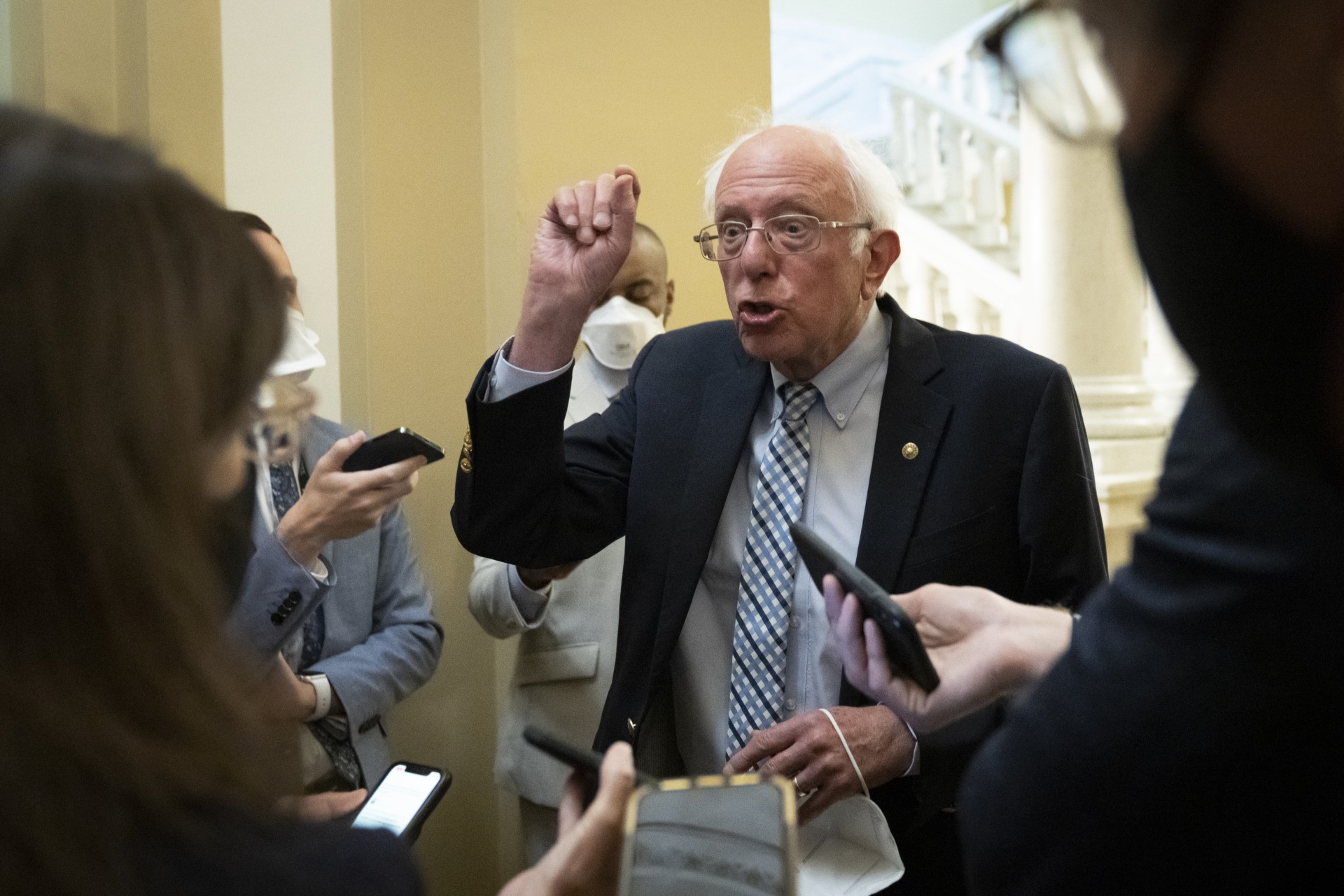
Sen. Bernie Sanders (I-VT) speaks to reporters outside the office of Senate Majority Leader Chuck Schumer (D-NY) at the U.S. Capitol September 30, 2021. (Drew Angerer/Getty Images)
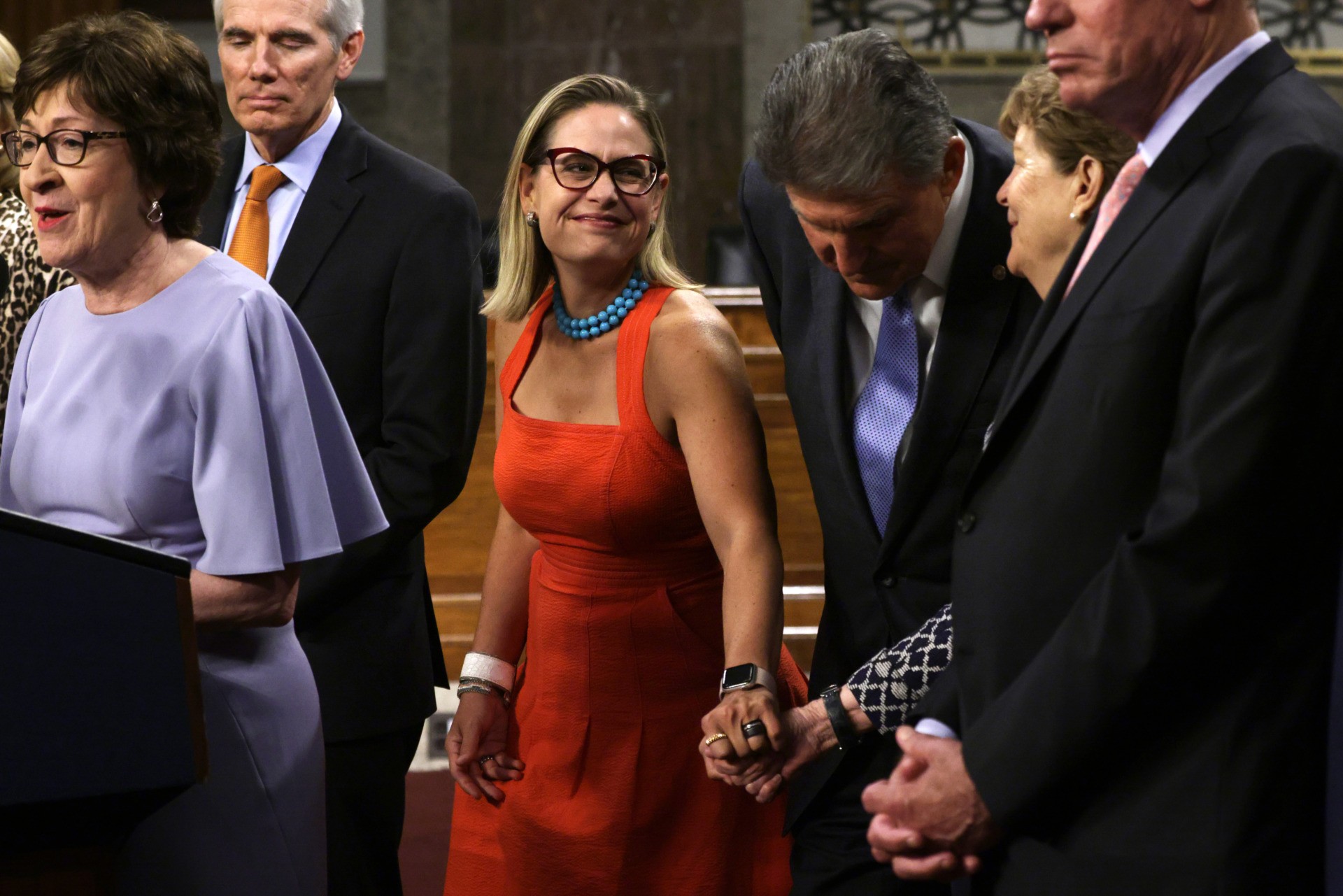
Sen. Kyrsten Sinema (D-AZ), next to Sen. Joe Manchin (D-WV), smiles at Sen. Jeanne Shaheen (D-NH) during a news conference on Capitol Hill after a procedural vote on the infrastructure framework on July 28, 2021. (Alex Wong/Getty Images)
A good explanation for Biden’s leftward shift comes from David Shor, a Democratic data analyst who has long warned his party that it has moved too far to the left. In Shor’s eyes, the progressive slant comes because, well, most Democratic activists are progs. As he said recently, “If you look inside the Democratic Party, there are three times more moderate or conservative nonwhite people than very liberal white people, but very liberal white people are infinitely more represented.”
We can pause to observe that very liberal people of any race make for a very liberal party– too liberal for its own good. Moreover, it follows that if the Democratic Party is well to the left, then the same will be true of the appointees and staffers in the Biden administration. In other words, if Middle Class Joe is surrounded by left-wingers, then he, too, becomes a left-winger–whether he knows it or not.
And so that’s how it came to be, as the Washington Post reported earlier this month, that Biden’s proposed plan, BIF plus BBB, is bigger than either the Great Society in the 1960s or Obamacare in the 2010s. In other words, big.
In fact, the 46th president seems to have never resolved three basic questions about the viability of his vision of his presidency:
First: Is it possible to launch an ambitious legislative agenda with such narrow majorities in Congress? As we are learning, a zero-seat majority in the Senate (with the vice president as the tie-breaker) and a bare five-seat majority in the House doesn’t allow for much maneuver.
Second: Given those narrow majorities and the general polarization of the country, did Biden ever have a chance of truly hammering out a centrist agenda, one not written by the left? Could he have really sat down with moderate Republicans and hammered out an overall centrist coalition that could provide middle-ballast for his presidency? Could he have avoided being so dependent on his left flank? We’ll never know.
Third: Does big-deficit fiscal policy have economic effects (inflation) prior to any presumed economic benefits of the spending down the road? We’ve learned in recent decades that the economy has greater tolerance for deficits than we once thought, and yet there still must come an inflationary breaking point. And so, for example, if gasoline and diesel prices are up a dollar or so in the last year, maybe we’ve hit that inflation-inflection point.
Since Biden never addressed these fundamental questions, maybe it’s no surprise that his administration has drifted to the left—and drifted toward the political rocks.
As Axios’ Mike Allen, a dean of Beltway commentary, wrote recently, “President Biden bit off too much, too fast in trying to ram through what would be the largest social expansion in American history, top Democrats privately say.”
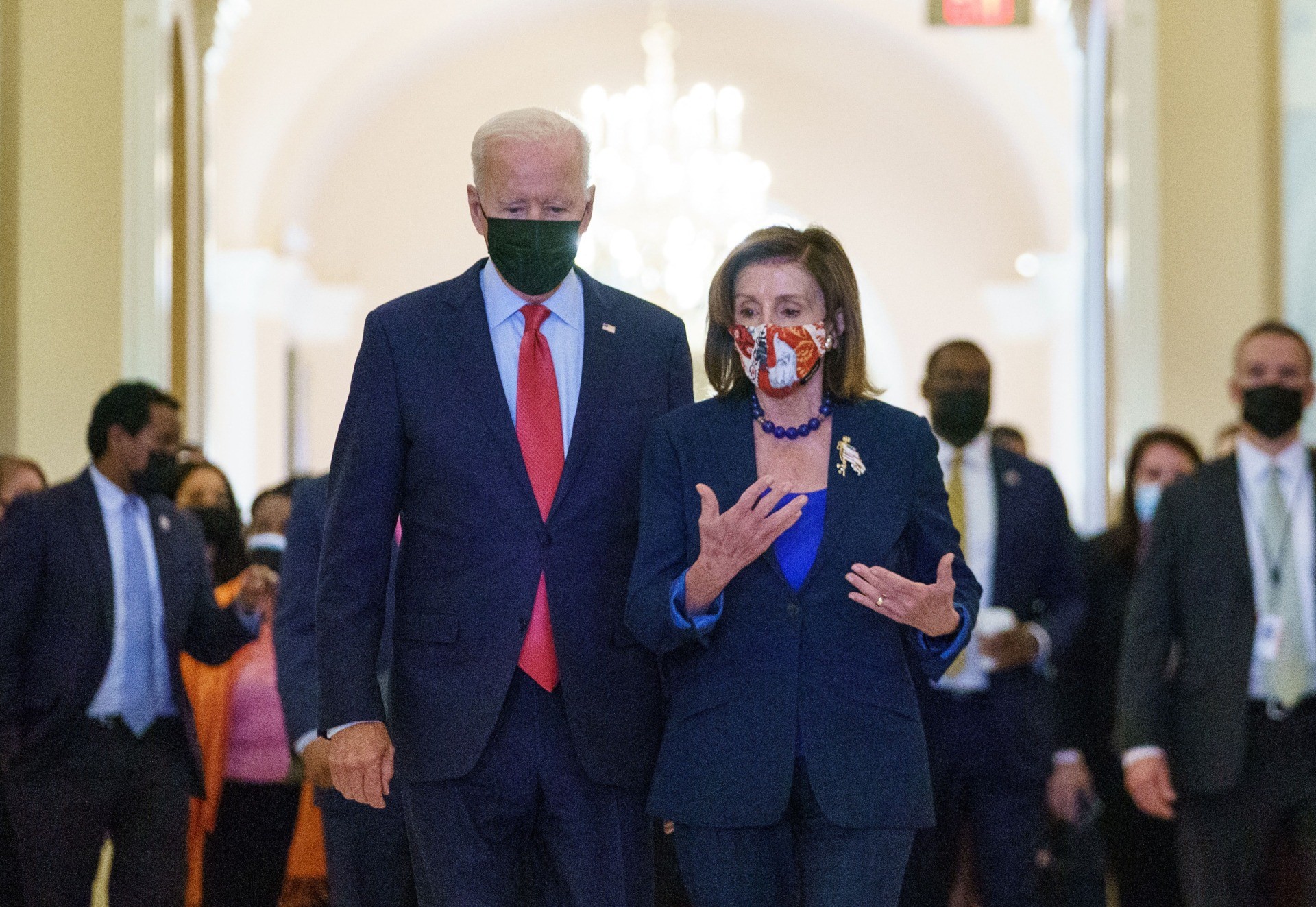
President Joe Biden walks with Speaker of the House Nancy Pelosi as he departs the Capitol after a caucus meeting on October 1, 2021, to whip up support for his infrastructure bill. (MANDEL NGAN/AFP via Getty Images)
Say It Ain’t So, Joe
In this challenging political and economic context, the old Joe Biden—the fella who won six senate terms representing a moderate state— would have been paddling toward the middle. After all, he’s the one who’s president, not Bernie Sanders.
Yet interestingly, Biden is still operating in lefty-world, and that could cost him his one big bipartisan achievement.
We can recall that the $1.2 trillion BIF passed the Senate on August 10 by a vote of 69:30. That is, 19 Republican senators voted for it. In terms of bipartisanship, that’s pretty good. And in fact, BIF is an actual blend of Democratic and (some) Republican priorities.
To be sure, there’s plenty of other spending, too, in BIF, enough so that most Republicans in Congress opposed it. Indeed, libertarian critic Steve Moore calls it an “atrocity,” and the Heritage Foundation labels BIF too costly and too woke.
Yet such criticism from the right would be moot if the Democrat-controlled House would simply vote “aye” on BIF. Then Biden could sign it into law, and the money would go flowing forth.
Yet that’s not happening, because House Democrats want both BIF and their $3.5 trillion BBB. And this hoped-for spending is in addition of the $1.9 trillion American Rescue Plan Act, which Biden signed into law on March 11.
Yet Rep. Ilhan Omar (D-MN), now speaking for Biden as she champions the BBB, told The New York Times, “If we pass the infrastructure bill alone, we are not even accomplishing 10 percent of his agenda.” Omar gets that 10 percent figure by comparing it to Bernie Sanders’ original agenda, which, as we might recall, was $30 trillion in 2020—and still as much as $6 trillion in June. In other words, Omar and her allies think they have come down as much on their price tag as they should have to.
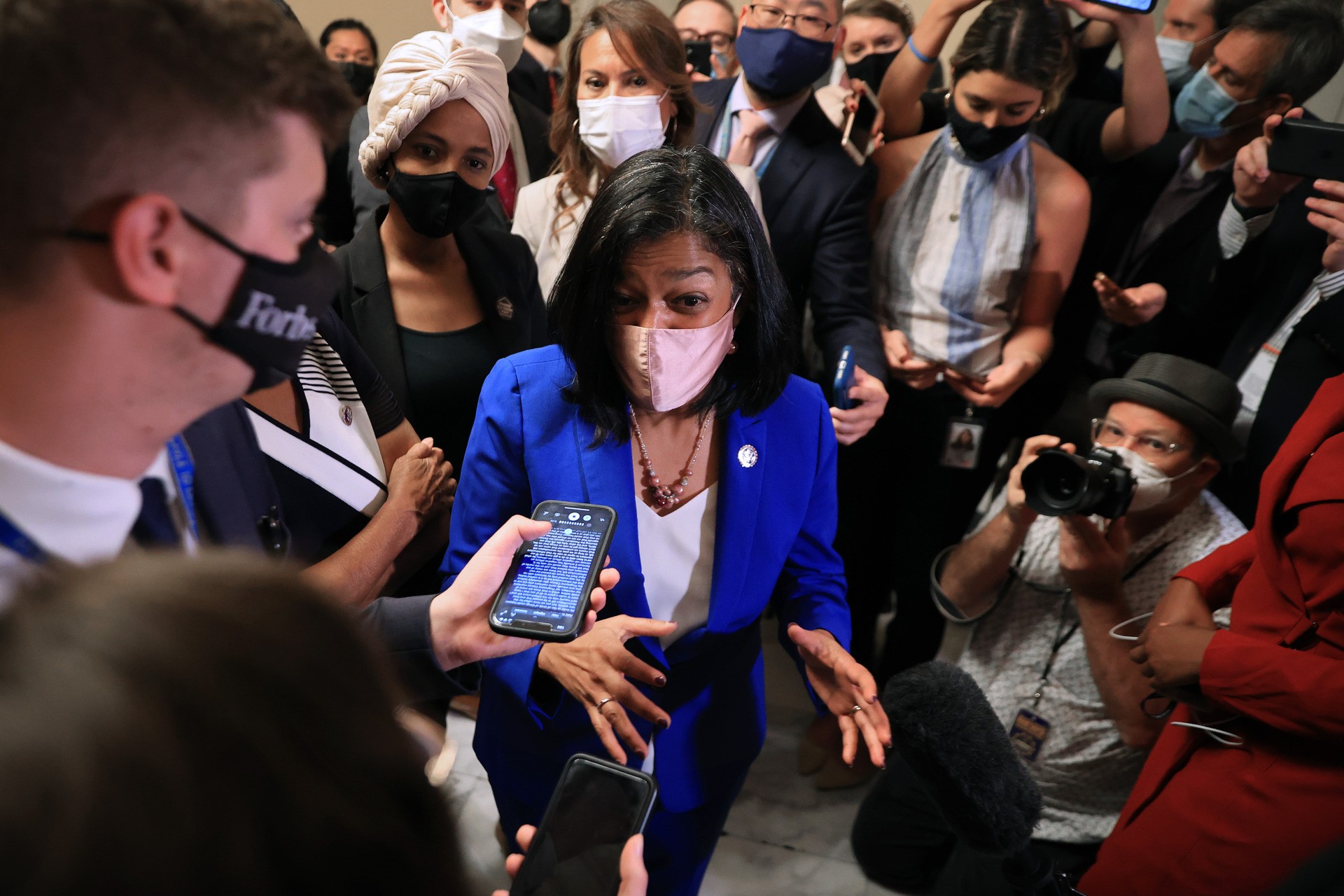
Congressional Progressive Caucus Chair Rep. Pramila Jayapal (D-WA), Sen. Ilhan Omar (D-MN), and Rep. Veronica Escobar (D-TX) talk to reporters about the infrastructure bill at the U.S. Capitol on September 30, 2021. (Chip Somodevilla/Getty Images)
Such intransigence led Rep. Dean Phillips, whom we met earlier, to exclaim, “The absence of pragmatism among Democrats is as troubling as the absence of principle among Republicans.” We can step back and observe that it’s normal for a Democrat to blast Republicans. But for a Democrat to blast fellow Democrats? In the middle of delicate negotiations? That’s disjunction. And yes, Phillips also said that his president had delivered a “nothing burger.” More disjunction.
It’s still possible that both bills—the $1.2 trillion BIF and the three-times-bigger BBB—will pass, although it’s increasingly likely that the latter bill will be whittled down to “only” $2 trillion or so.
And yes, no matter what happens on Capitol Hill, Biden’s presidential term extends for more than three years. Yet his presidency, ill-planned from the beginning, has been hit hard by intra-party squalls, and so it’s off course and maybe lost in the haze.
The same was true for Jimmy Carter in the first year of his presidency 44 years ago.

